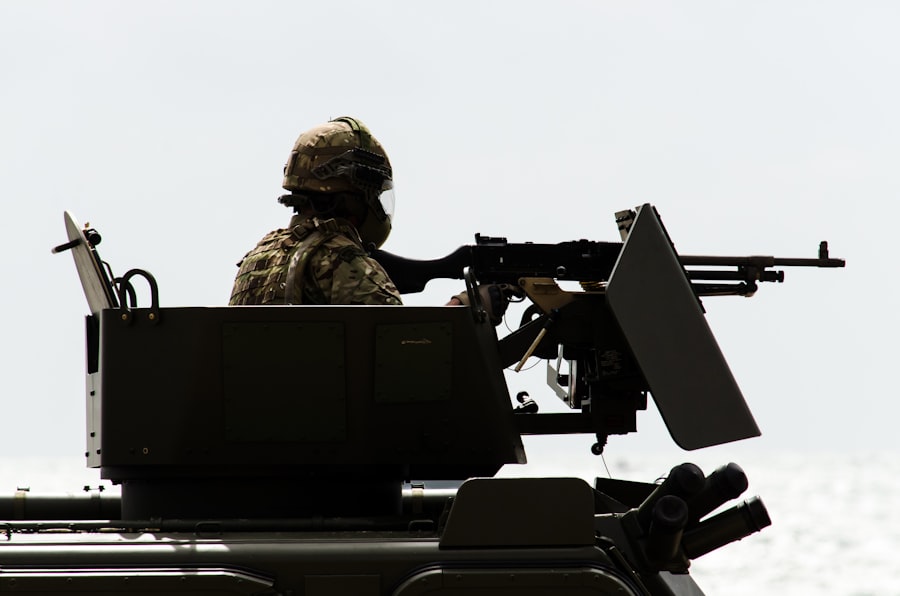Military automation represents a transformative shift in the way armed forces operate, integrating advanced technologies to enhance efficiency, precision, and effectiveness in various military operations. This evolution encompasses a wide range of systems, from unmanned aerial vehicles (UAVs) to automated logistics and command systems. As nations strive to maintain a competitive edge, the adoption of automated systems has become increasingly prevalent, promising to revolutionize traditional military strategies and tactics.
The integration of automation into military frameworks not only aims to reduce human involvement in high-risk scenarios but also seeks to optimize resource allocation and decision-making processes. The rise of military automation is driven by the need for rapid response capabilities in an ever-changing global landscape. As conflicts become more complex and multifaceted, the ability to deploy automated systems can provide a strategic advantage.
However, this shift also raises critical questions about the implications of relying on technology in warfare. The balance between leveraging automation for operational superiority and ensuring that such systems are secure and reliable is a challenge that military leaders must navigate carefully. As the landscape of warfare evolves, understanding the nuances of military automation becomes essential for both policymakers and the public.
Key Takeaways
- Military automation offers increased efficiency, accuracy, and precision in various tasks, including surveillance, logistics, and combat operations.
- Advantages of military automation include reduced human risk, faster decision-making, and enhanced operational capabilities in complex and dynamic environments.
- Potential risks and vulnerabilities of military automation include system malfunctions, cyber attacks, and unintended consequences of autonomous decision-making.
- Cybersecurity threats to military automation encompass hacking, data breaches, and sabotage, which can compromise sensitive information and disrupt operations.
- Human error in military automation remains a significant concern, as it can lead to unintended consequences and failures in decision-making processes.
The Advantages of Military Automation
One of the most significant advantages of military automation is the enhancement of operational efficiency. Automated systems can process vast amounts of data at speeds far beyond human capabilities, allowing for quicker decision-making in critical situations. For instance, drones equipped with advanced sensors can gather intelligence and conduct surveillance missions without putting human lives at risk.
This capability not only saves lives but also enables military forces to respond more swiftly to emerging threats, thereby increasing their overall effectiveness on the battlefield. Moreover, military automation can lead to substantial cost savings over time. By reducing the need for human personnel in certain roles, armed forces can allocate resources more effectively.
Automated systems can perform repetitive tasks with high precision, minimizing errors that could lead to costly mistakes. Additionally, the use of robotics in logistics and supply chain management can streamline operations, ensuring that troops receive necessary supplies promptly and efficiently. As a result, military organizations can focus their budgets on advanced technologies and training, further enhancing their operational capabilities.
The Potential Risks and Vulnerabilities of Military Automation

Despite its numerous advantages, military automation is not without its risks and vulnerabilities. One of the primary concerns is the potential for system failures or malfunctions. Automated systems rely heavily on software and hardware components that can be susceptible to technical glitches or unforeseen issues.
In high-stakes environments such as combat zones, even minor failures can have catastrophic consequences. The reliance on technology raises questions about the robustness and reliability of these systems in critical situations. Additionally, the increasing complexity of automated systems introduces new vulnerabilities that adversaries may exploit.
As military forces integrate more sophisticated technologies, they may inadvertently create opportunities for cyberattacks or other forms of sabotage. The interconnected nature of modern military systems means that a breach in one area could compromise entire operations. Therefore, understanding and addressing these vulnerabilities is crucial for maintaining operational integrity and ensuring that automated systems function as intended.
Cybersecurity Threats to Military Automation
| Threat Type | Impact | Preventive Measures |
|---|---|---|
| Malware | Data theft, system disruption | Regular system updates, antivirus software |
| Phishing | Unauthorized access, data breaches | Employee training, email filtering |
| Denial of Service (DoS) | System downtime, disruption of operations | Firewall protection, traffic monitoring |
| Insider Threats | Data leaks, sabotage | Access control, employee monitoring |
Cybersecurity threats pose a significant challenge to military automation, as adversaries continuously seek ways to exploit weaknesses in automated systems. The interconnectedness of military networks means that a successful cyberattack can disrupt operations, steal sensitive information, or even manipulate automated systems to act against their intended purpose. As military forces increasingly rely on digital technologies for command and control, the potential impact of cyber threats becomes more pronounced.
To mitigate these risks, military organizations must prioritize cybersecurity measures throughout the development and deployment of automated systems. This includes implementing robust encryption protocols, conducting regular security assessments, and fostering a culture of cybersecurity awareness among personnel. Additionally, collaboration with private sector experts in cybersecurity can provide valuable insights into emerging threats and best practices for safeguarding military automation against potential attacks.
Human Error in Military Automation
While automation aims to reduce human involvement in high-risk scenarios, it does not eliminate the potential for human error entirely. In fact, the interaction between humans and automated systems can introduce new challenges. For instance, operators may become overly reliant on automated systems, leading to complacency or a lack of situational awareness.
This phenomenon can result in critical mistakes during operations, particularly if operators fail to intervene when necessary. Furthermore, the design of automated systems plays a crucial role in minimizing human error. If systems are not user-friendly or intuitive, operators may struggle to understand their functions or misinterpret data outputs.
Therefore, it is essential for military organizations to invest in comprehensive training programs that emphasize the importance of human oversight and decision-making in conjunction with automated systems. By fostering a collaborative relationship between humans and technology, armed forces can enhance operational effectiveness while mitigating the risks associated with human error.
Ethical and Legal Issues in Military Automation

The integration of automation into military operations raises profound ethical and legal questions that must be addressed by policymakers and military leaders alike. One major concern revolves around the use of autonomous weapons systems capable of making life-and-death decisions without human intervention. The potential for such systems to operate independently raises moral dilemmas regarding accountability and responsibility for their actions.
In scenarios where autonomous weapons cause unintended harm or civilian casualties, determining liability becomes complex.
International humanitarian law stipulates principles such as distinction and proportionality, which require combatants to differentiate between military targets and civilians while minimizing harm to non-combatants.
Ensuring that automated systems adhere to these principles necessitates careful consideration during their design and implementation phases. As military automation continues to evolve, ongoing dialogue about ethical standards and legal regulations will be essential to navigate these challenges responsibly.
The Impact of Artificial Intelligence on Military Automation
Artificial intelligence (AI) plays a pivotal role in advancing military automation by enabling systems to learn from data and adapt to changing circumstances. AI algorithms can analyze vast datasets to identify patterns, predict outcomes, and inform decision-making processes in real-time. This capability enhances situational awareness for military commanders and allows for more informed strategic planning.
For example, AI-driven analytics can assist in threat assessment by processing intelligence reports faster than human analysts. However, the integration of AI into military automation also introduces new complexities and challenges. The reliance on algorithms raises concerns about bias in decision-making processes, particularly if AI systems are trained on flawed or incomplete data sets.
Moreover, as AI technologies continue to evolve, ensuring transparency and accountability in their operations becomes increasingly important. Military organizations must establish guidelines for AI usage that prioritize ethical considerations while harnessing its potential benefits for operational effectiveness.
The Role of Human Oversight in Military Automation
Despite the advancements in military automation, human oversight remains a critical component of effective operations. Automated systems should complement human decision-making rather than replace it entirely. Human operators bring invaluable experience, intuition, and ethical considerations that machines cannot replicate.
Therefore, establishing clear protocols for human oversight is essential to ensure that automated systems operate within acceptable parameters. Moreover, fostering a culture of collaboration between humans and machines can enhance overall mission success. Training programs should emphasize the importance of human judgment in conjunction with automated capabilities, encouraging operators to remain engaged and vigilant during operations.
By maintaining a balance between automation and human involvement, military organizations can leverage technology’s advantages while safeguarding against potential risks associated with over-reliance on automated systems.
Case Studies of Vulnerabilities in Military Automation
Examining case studies of vulnerabilities in military automation provides valuable insights into potential pitfalls and areas for improvement. One notable example is the 2007 cyberattack on Estonia, which demonstrated how interconnected systems could be disrupted by coordinated cyber efforts from adversaries. This incident highlighted the importance of cybersecurity measures in protecting automated military infrastructure from external threats.
Another case study involves incidents involving unmanned aerial vehicles (UAVs) that experienced technical malfunctions during missions due to software glitches or communication failures. These incidents underscore the necessity for rigorous testing and validation processes before deploying automated systems into operational environments. By analyzing past vulnerabilities, military organizations can develop strategies to enhance system resilience and mitigate risks associated with automation.
Mitigating Vulnerabilities in Military Automation
To effectively mitigate vulnerabilities associated with military automation, organizations must adopt a proactive approach that encompasses multiple strategies. First and foremost, investing in robust cybersecurity measures is paramount to safeguarding automated systems from external threats. This includes regular security audits, penetration testing, and continuous monitoring of network activity to detect anomalies.
Additionally, fostering a culture of resilience within military organizations is essential for addressing vulnerabilities related to human error or system failures. Training programs should emphasize adaptability and critical thinking skills among personnel operating automated systems. Encouraging open communication about potential risks allows teams to identify issues early on and implement corrective actions before they escalate into significant problems.
The Future of Military Automation and Vulnerability Management
As military automation continues to evolve rapidly, its future will likely be shaped by advancements in technology alongside an increasing focus on vulnerability management. The integration of emerging technologies such as quantum computing may enhance encryption methods used to protect automated systems from cyber threats while improving data processing capabilities for decision-making. Moreover, ongoing research into ethical frameworks surrounding military automation will play a crucial role in shaping policies governing its use on the battlefield.
Striking a balance between leveraging technological advancements for operational superiority while ensuring accountability will be paramount as nations navigate this complex landscape. In conclusion, while military automation offers numerous advantages that can enhance operational efficiency and effectiveness, it also presents significant risks that must be carefully managed. By prioritizing cybersecurity measures, fostering human oversight, addressing ethical considerations, and learning from past vulnerabilities through case studies, military organizations can navigate the challenges posed by automation effectively.
As technology continues to advance at an unprecedented pace, proactive vulnerability management will be essential for ensuring that military automation serves its intended purpose without compromising safety or ethical standards.
In recent years, the increasing reliance on automation in military operations has raised significant concerns about potential vulnerabilities. Automated systems, while enhancing efficiency and precision, can also be susceptible to cyberattacks and malfunctions, which could compromise national security. An insightful article discussing these issues can be found on In The War Room’s website. It delves into the complexities and risks associated with military automation, highlighting the need for robust cybersecurity measures and strategic planning. For a deeper understanding of these challenges, you can read the full article by visiting In The War Room.
🔍WATCH THIS! The Secret Weakness That Will Break The US Military🧭
FAQs
What is military automation?
Military automation refers to the use of technology and artificial intelligence to automate various tasks and processes within the military, such as surveillance, logistics, and combat operations.
What are the potential vulnerabilities of military automation?
The potential vulnerabilities of military automation include cyber attacks, hacking, system malfunctions, and the potential for adversaries to exploit weaknesses in the technology to gain an advantage.
How do cyber attacks pose a threat to military automation?
Cyber attacks can disrupt or disable military automation systems, leading to a loss of critical capabilities and compromising the safety and security of military personnel.
What are the implications of vulnerabilities in military automation?
Vulnerabilities in military automation can lead to compromised mission effectiveness, loss of sensitive information, and potential harm to military personnel and civilians.
What measures are being taken to address the vulnerabilities of military automation?
Military organizations are implementing cybersecurity measures, conducting regular assessments of automation systems, and investing in research and development to enhance the resilience and security of military automation technologies.




